 |
||
|
||
| ||
The new revision of the VIA Apollo KT266 chipset has been rumored for a long time already. And recently we have received a sample of a mainboard from VIA Technologies (so called a Reference Board) which is based on the VIA Apollo KT266A. What's new in the KT266A? Its specifications are identical to the KT266. But according to VIA Technologies its memory controller was redesigned. So, we decided to conduct those tests where the VIA KT266 lost to AMD-760 and SiS 735. The following equipment was used in the tests:
Software:
Specifications of the boards:
VIA VT5577A ReferenceWell, the board is not meant for an ordinary user. Nevertheless, we think it would be interesting for you to take a gander at. The VT5577A hasn't turned to be bright or extraordinary, like the previous model on the P4X266. The north bridge is still pin-compatible with the previous one, and the marking of the chip has remained the same (the production samples will be marked as VT8366A). The box houses a disc with new drivers for this chipset from VIA. So, first of all we decided to test them on the old revision of the chipset. Unfortunately, no performance boost was gained. Besides, in the box you can find a manual including guide how to carry out tests and the board's features. 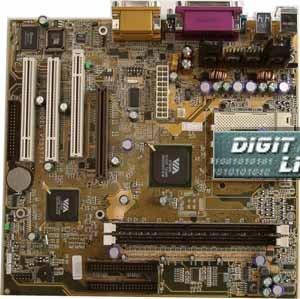 The PCB is equipped with 3 PCIs, 1 AGP slot, a set of standard LPT, COM, USB. The photo shows that the layout isn't what the board can boast about, but the assemblage is of high quality. The BIOS features a great deal of various settings. But the trend of hiding of the majority of them in production boards will likely take place here as well. Chaintech 7SID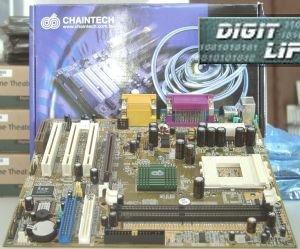 The board we have received is also a pre-production sample, but it scored very good results. 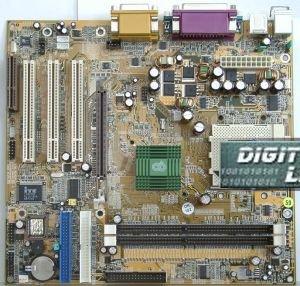 In the box one can find ATA66/100 and FDD cables, a scanned sheet of paper with functions of switches and positions of different connectors and a CD-R disc with a good installer instead of just a set of drivers. The site of the company says that the board will ship together with a "Value Pack 2000" disc with freeware programs. This little board has a typical set of components. Apart from an integrated sound controller with a connector on a front panel with audio-outs there is a smart-card reader connector. In all other respects, it is a usual board. It is equipped with 11 2200 uF capacitors and a little set of switches. One is used to set a frequency of the CPU or memory - 100/100, 100/133 and 133/133 MHz, another allows us to turn on the computer with a PS/2 mouse or keyboard, and the third will help us clear the CMOS contents. The BIOS is based on v6.00 from AWARD and has a lot of settings: you may adjust memory settings, improve the performance of the AGP bus, manually distribute interrupts among PCI slots. As far as processor overclocking is concerned, there is nothing you can do about it. Despite its disadvantages, the board will work excellently in a high-efficient home computer. ASUS A7V266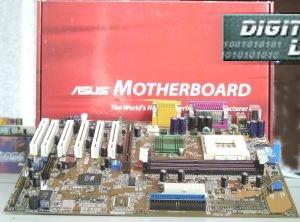 Asus released a board on the KT266 after all other companies had already done it. Maybe, it just wanted the board not to be raw. Although this is a pre-production sample, the red box contains the documentation, ATA100 and FDD cables and a CD-R disc (drivers, Adobe Acrobat Reader 4.05, PC-Cillin2000 v. 7.0 from Trend Micro, Power Player SE 5.0, PowerDVD Trial 3.0, VideoLive Mail 4.0 from CyberLink, 3Deep for adjusting color balance in games, and ASUS programs - screensaver, ASUS Update and ASUS PCProbe (system monitoring utility). 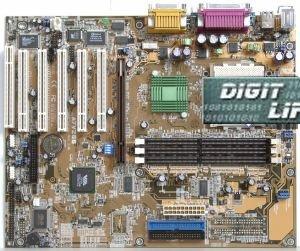 Since it is the first board of the family, there are an unsoldered chip and connectors, where we must see an IDE RAID controller from Promise with ATA100 connectors. Besides, the board is equipped with an audio chip from C-Media featuring 6-channel sound output. But a bracket for the rear panel is absent; Line-In and Mic-In connectors, thus, become outputs of central and rear channels with the drivers's help. The only drawback is location of an FDD connector: it is placed behind 4 and 5 PCI slots, thus making the cable stretching along the whole case. The board has 4 3300uF and 3 1500uF capacitors. Besides, there are SMARTCARD and AFPANEL connectors (the latter is meant for connecting ASUS iPanel). Among a great deal of jumpers the most interesting are 4 units of switches: for setting a base processor frequency, a multiplier and Vcore. The fourth will help you choose a processor type - Athlon, Duron or Athlon 4 (Palomino). The most of settings are hidden in the BIOS Setup. The BIOS is based on the v. Medallion 6.00 from Award. It offers a great variety of modes for memory, AGP and PCI buses; you may manually distribute interrupts among PCI slots etc. With the JumperFree technology you can change many characteristics of the system from the BIOS Setup in the version of Asustek. There are such possibilities as setting of Vcore (1.525-1.85V, 0.025V step), of a multiplier (x5-x13), of a FSB frequency (100-227MHz(!) in 1 MHz steps). Abit KG7-RAID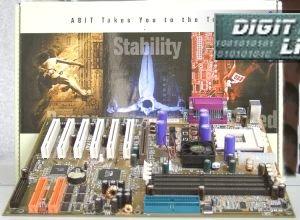 The board based on the AMD-760 chipset is presently one of the leaders among such boards. With the board you get 2 ATA66/100 and one FDD cables, a bracket with two additional USB ports for the rear computer panel, a CD with software, a diskette with drivers for IDE RAID and a user's manual with a lot of ads of multimedia products from this company. The CD contains WinDVD player, Hardware Doctor, Adobe Acrobat Reader and a set of programs from Buzzsoft - SoftCard Manager, SoftCopier, SoftPostCard, SoftBulkEmail. Besides, there is a utility for a low-level formatting of hard discs from AWARD. 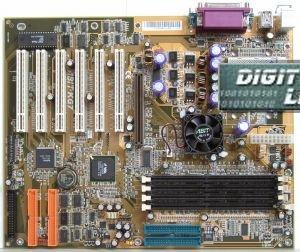 The layout of the board is not the best: IDE RAID and FDD connectors are placed right behind the PCI slots (it prevents installation of long cards into these slots and worsens air circulation). The integrated sound controller is absent, but there are IDE RAID on the HPT370A chip. So, we have two more ATA100 channels and can build the RAID of 0, 1, 0+1 levels. The north bridge is equipped with a heatsink and a fan. 6 4700 uF capacitors and 2 2200 uF ones are also meant to make the board more stable. The switch is only one - for clearing the CMOS contents. The BIOS is based on v6.00 from AWARD. The "SoftMenu III" item will help you change a FSB frequency from 100 to 200 MHz in 1 MHz steps, set the correlation of FSB, SDRAM and PCI frequencies - 4:4:1 or 3:3:1, change voltages of the core, chipset and memory. The enormous heap of settings for memory, AGP bus, chipset will certainly please you. Besides, interrupts can be manually distributed among PCI slots. PerformanceApart from bugfixes and overall performance increase, VIA Technologies aimed in the new chipset an elimination of the superiority in some tests of AMD-760 and SiS 735 chipsets. That is why we will study the VIA KT266A exactly with this idea in mind. But there is one more point I'd like to attract your attention to. We have taken the ASUS A7V266 as a mainboard on the "old" VIA KT266. This board performs much better in many cases; ASUS, as the tests show, managed to realized some of the VIA's ideas by a fine tuning of the board on the KT266. Well, let's see whether the VIA's engineers could outbid tuners from the R&D department from ASUSTeK :) MadOnion.com 3DMark 2001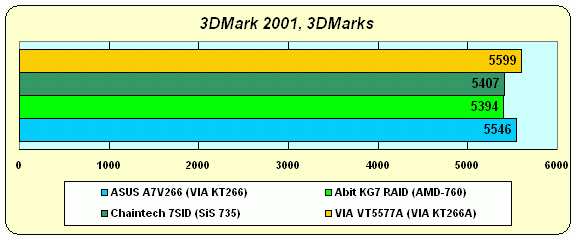 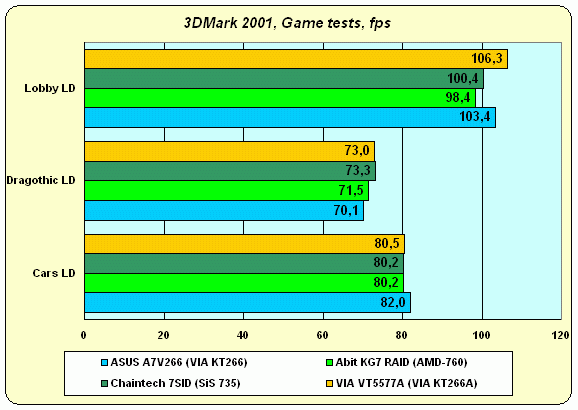 The general performance is more or less neutral at the expense of the Cars and Dragothic subtests, while in the Lobby the new chipset outscores AMD-760, SiS 635 and ASUS A7V266 on the KT266. Quake III The results of the KT266A are incredible! The 8% breakaway! And this is just a Reference Board! Expendable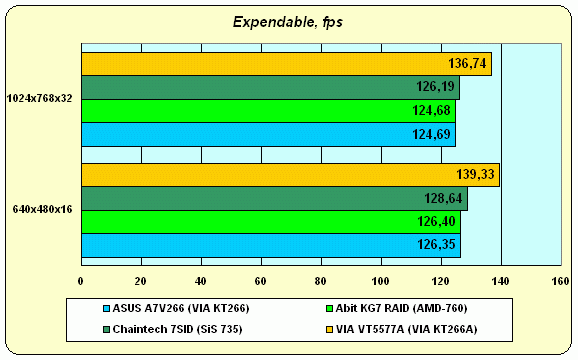 In this game the productivity is defined by not the memory linear reading speed but by the latency of the memory access. And here, in the 640x480x16 mode the KT266A achieves a 8.3% lead over the fastest contender. Unreal Tournament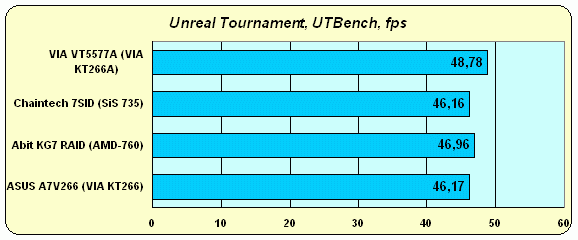 I think that this test doesn't depend strongly on the memory subsystem. The computation power of the CPU is likely of the utmost importance here. But the KT266A is still a winner here. ZD Winstone 2001 and BAPCo SYSmark 2001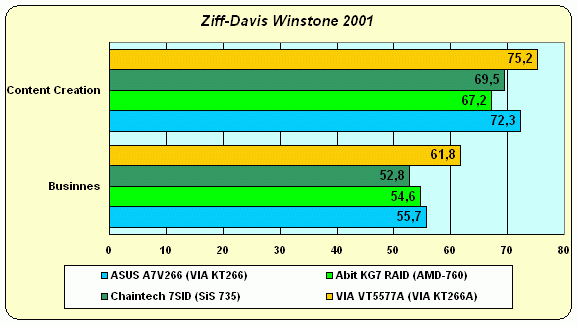 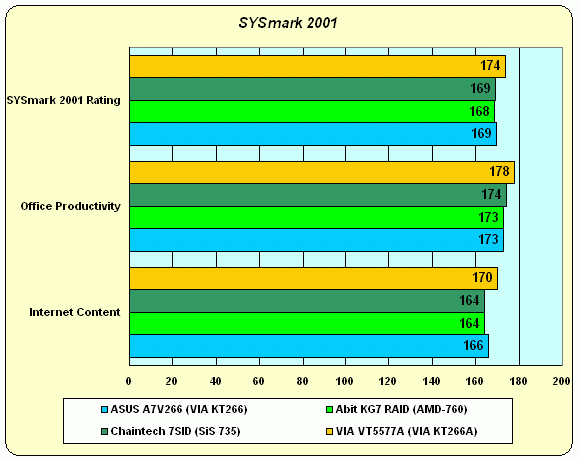 In the Ziff Davis test the difference between the participants is more vivid. Besides, while in the Content Creation Winstone the AMD-760 loses to the SiS 735, in the SYSmark 2001 Internet Content Creation both are right about the same. According to these results and those of the Pentium 4 2 GHz I suspect that this test contains a plenty of applications optimized for the new architecture of the Pentium 4 and its instruction sets, thus making it unsuitable for estimation of the performance of the old CPUs and boards on them. Our hero shines everywhere, and in the Ziff Davis the difference is simply stunning :) 3DStudio MAX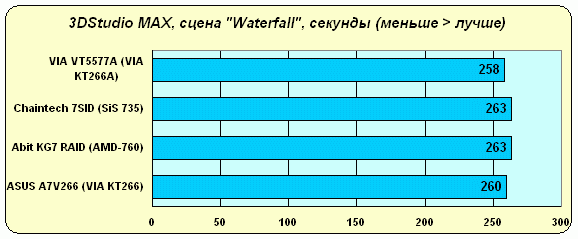 Waterfall scene, sec. (the less, the better) In the 3DStudio MAX the determining factor is also the CPU's computation power. The VIA KT266A is just a bit better than the old one, but it makes no sense to replace the old chipset with the new one. SPEC ViewPerf 6.1.2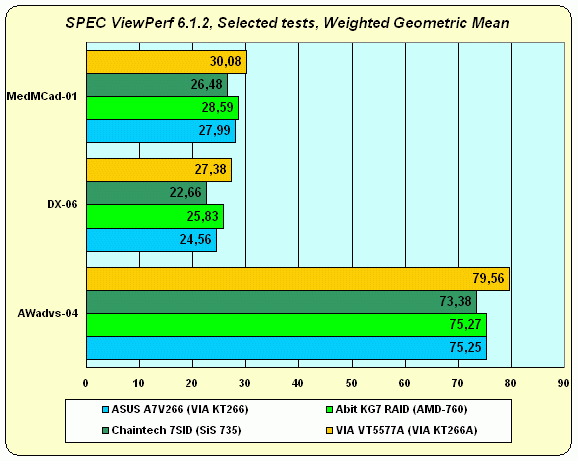 The VIA KT266A is again considerably ahead of the competitors: almost a 6% difference in the AWadvs-04, 6% gap in the DX-06 (IBM Data Explorer) and 5% lead in the MedMCAD-01. The VIA KT266's worst competitor in all subtests except the AWadvs-04 (Alias|Wavefront Advanced Vizualiser core) is the AMD-760. Well, at last VIA has outdone the AMD-760, as well as its old version. Wstream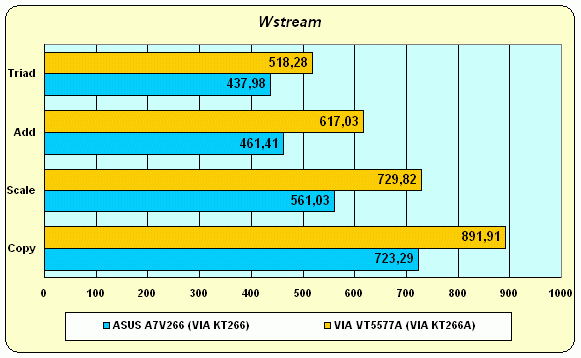 The Wstream allows estimating the peak performance of the memory subsystem. Such a test can show a 20% difference while in a real application you will hardly get here 5%. On the other hand, this helps to estimate the product when these results supplement diagrams of performance achieved in real applications. In this test we decided to compare only the VIA KT266 and the VIA KT266A. It is clear that the memory subsystem is enhanced in all parameters. ConclusionWell, VIA Technologies has achieved its goal, and we have got an excellent chipset. But let me look at the possible consequences. First, it doesn't make sense anymore to purchase boards on an expensive but not the fastest AMD-760. In its time the chipset supported the Athlon + DDR SDRAM platform and not its time is over. The SiS 735 has also lost its advantage in some tests, but its market sector is still alive: it is low-end and low-middle-end segments where the determining factor is price. The KT266A will be a fly in the ointment only for
those who have recently bought a KT266 based board... Write a comment below. No registration needed!
|
Platform · Video · Multimedia · Mobile · Other || About us & Privacy policy · Twitter · Facebook Copyright © Byrds Research & Publishing, Ltd., 1997–2011. All rights reserved. |